The Lovers card’s astrology and Hebrew letter provide an understanding of its basic meanings of love, communication, and choices, but the pictures tell us more.
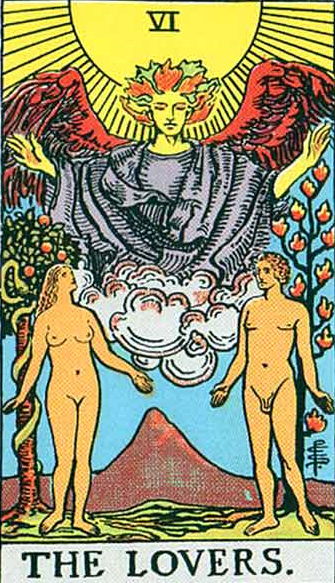
The Rider, Waite, Smith version is the most symbolically complete of the three we’ll be examining, so I’ll start with that. The card shows a man looking at a woman who is looking at an angel.
![]() The man is Adam, The Magician, and The Emperor. He is the self-conscious, the left brain, the part of us that is logical, practical, and “sane”. It gets us from here to there on time and presents a consistent personality to the world. To make this really clear, Pamela Coleman Smith drew a tree with twelve flaming fruits right behind him. These are the twelve signs of the zodiac (not the twelve apostles). Each flame has three parts, one for each decan of the sign. So the tree behind the man is the twelve basic personalities and the thirty-six sub-personalities of humanity.
The man is Adam, The Magician, and The Emperor. He is the self-conscious, the left brain, the part of us that is logical, practical, and “sane”. It gets us from here to there on time and presents a consistent personality to the world. To make this really clear, Pamela Coleman Smith drew a tree with twelve flaming fruits right behind him. These are the twelve signs of the zodiac (not the twelve apostles). Each flame has three parts, one for each decan of the sign. So the tree behind the man is the twelve basic personalities and the thirty-six sub-personalities of humanity.
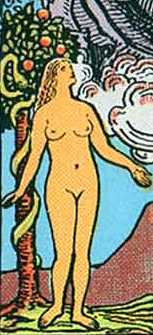 The woman is Eve, The High Priestess, and The Empress. She is the creative, intuitive, subconscious, right brain, part of us. The tree behind her has a serpent spiraling up it and five fruits. The serpent symbolizes the underworld and all the stuff that’s secret and hidden and dangerous. The five fruits are the five senses or feelings.
The woman is Eve, The High Priestess, and The Empress. She is the creative, intuitive, subconscious, right brain, part of us. The tree behind her has a serpent spiraling up it and five fruits. The serpent symbolizes the underworld and all the stuff that’s secret and hidden and dangerous. The five fruits are the five senses or feelings.
The angel is the Raphael, Archangel of air and the east. You can tell because he’s yellow, the color of air and the east. Gemini, the card’s 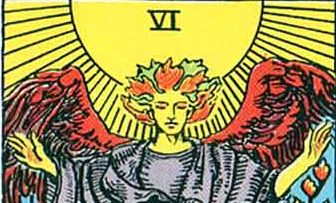 associated sign, is an air sign, so that’s why Raphael is pictured and not one of the other archangels. He represents the super-conscious, Jung’s cosmic unconscious, the Akashic Records, and/or the divine.
associated sign, is an air sign, so that’s why Raphael is pictured and not one of the other archangels. He represents the super-conscious, Jung’s cosmic unconscious, the Akashic Records, and/or the divine.
So we have what looks suspiciously like a trinity. Those pesky things are everywhere. This one is the trinity of the human psyche: the conscious, the subconscious, and the super-conscious or divine. Yes, divine—most occultists teach that “There is no part of us that is not of the gods.” (Dion Fortune). The thing to notice here is the communication pathway. The man looks to the woman, who looks to the angel. What this card is telling us is that if we want to communicate with the divine, we must do it through the subconscious. Which means that the conscious mind, which formulates the question or desire must be on good speaking terms with the subconscious. If it’s not, the request never gets through or gets garbled, and things start going very wrong.
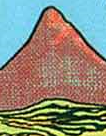 The mountain behind the two lovers is the peak of our aspirations, the symbol of what we are here on this earth to accomplish. It’s there to remind us that once the above three parts of our psyche are in harmony, we can achieve the seemingly impossible; but if they aren’t, we are lost. We may be very successful and wealthy, but if the thing that got us that wealth and success somehow short-circuited the above path of communication, we can never be truly happy and love will never stay in our lives.
The mountain behind the two lovers is the peak of our aspirations, the symbol of what we are here on this earth to accomplish. It’s there to remind us that once the above three parts of our psyche are in harmony, we can achieve the seemingly impossible; but if they aren’t, we are lost. We may be very successful and wealthy, but if the thing that got us that wealth and success somehow short-circuited the above path of communication, we can never be truly happy and love will never stay in our lives.
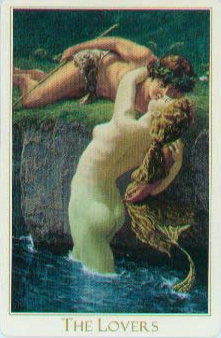
The next card is from the Victorian Romantic Tarot. It is the second of two Lovers cards that come with the second edition. None of the other keys in this deck give the reader a choice of which card to use in a reading. Why does this not surprise me?
If we assume that the divine is implied, this card is telling us the same thing as the RWS card plus a few other things. Here we see a hunter (consciousness) and his mermaid quarry (subconscious) locked in an amorous embrace.
They are obviously in communication. The conscious mind has laid down his tools (notice the spear) and lovingly embraced the subconscious, because he has come to realize that the subconscious cannot be bullied or coerced into submission, she must be seduced and persuaded. This is one lesson the RWS card doesn’t teach.
The above scenario encourages the reader to speculate further. These lovers definitely have some choices to make. If they continue with their relationship it will result in either a drowning man or a fish out of water. A closer examination of the card reveals that the mermaid, or subconscious, has already chosen and is adapting. She is growing legs. The subconscious is infinitely resourceful and flexible and will bend over backwards to please if she is asked nicely. But he (the conscious mind) must be careful what he asks of her. If the mermaid does grow legs, will her every step be agony, like Hans Christian Anderson’s Little Mermaid? Will their love be changed forever?
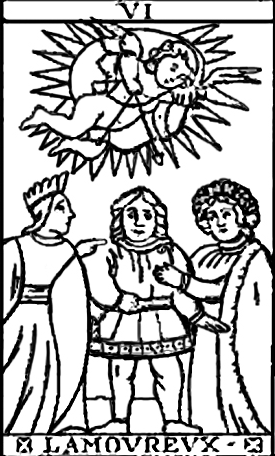
In the earlier tarot decks, A man and two women are pictured with cupid, or Eros, fluttering above them ready to shoot the man in the heart. In The Devil’s Picture Book, Paul Huson suggests that these cards were a depiction of the fateful Judgement of Paris, with one or two goddesses pictured instead of three.
Once upon a time, many years BCE, every one who was anyone on Mt Olympus was attending Zeus’s celebration of the marriage of Peleus, a 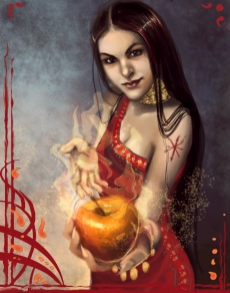
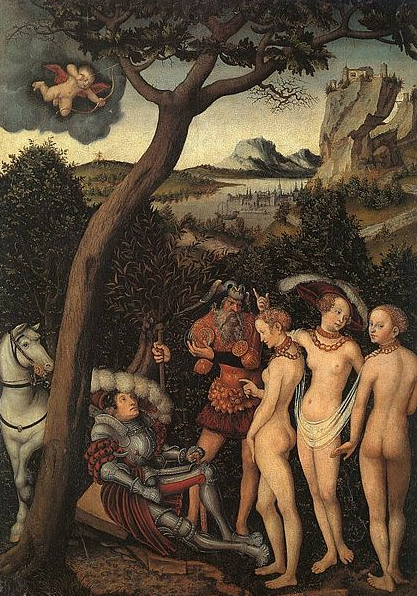
The divine ladies immediately went to work on Paris. Hera offered him the kingship of Europe and Asia if he would but choose her. Athena offered him success in battle. But Aphrodite simply undid her girdle, and when the hapless young shepherd looked upon her beauty, her son, Eros, shot him through the heart. He fell madly in love with the Goddess of Love, and she promised him the most beautiful woman on earth for his bride if he chose her. Guess who won?
Unfortunately, the most beautiful woman on earth was Helen, wife of the Spartan King Menelaus. When Paris ran off with his wife, the Greeks attacked Troy and eventually burned it to the ground. And so the only good thing that came from The Judgement of Paris was The Illiad.
Hindsight being 20/20 and unaffected by the wiles of Aphrodite, it is obvious to us that the best thing for Paris to have done would have been to cut the apple into thirds, award each goddess a piece, and tell them that they were all equally fair. This is also the psychological lesson of The Lovers card. Remember that trinity? Hera, queen of the gods is the super-consciousness, Aphrodite is the subconscious, and Athena is the self-conscious. For a person to be healthy and happy, all three are equally important and must get along. The sly, side lesson of the Marseilles deck Lovers is that this is very difficult because our lusts and desires (the barbs of Eros) are constantly interfering.
In the Hero’s Journey, The Lovers are sometimes exactly that, two main characters in love. Of course, they must be in conflict or faced with a difficult choice, or the story will be boring. Romeo and Juliet and Peter Pan and Wendy come to mind. The card also represents a major plot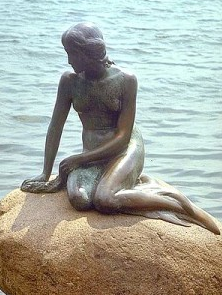
It is these decisions and the motivations behind them that give the story interest and poignancy; that give the reader insight into the characters; and that drive the plot.
And the motivation behind all good decisions is true, unselfish love.


3 thoughts on “The Major Arcana and The Hero’s Journey: The Lovers, Part II”
I can see how these fit with the hero’s journey: see http://www.clickok.co.uk/index4.html and related videos at http://www.youtube.com/user/clickokDOTcoDOTuk
Thanks for the link. It’s really helpful.